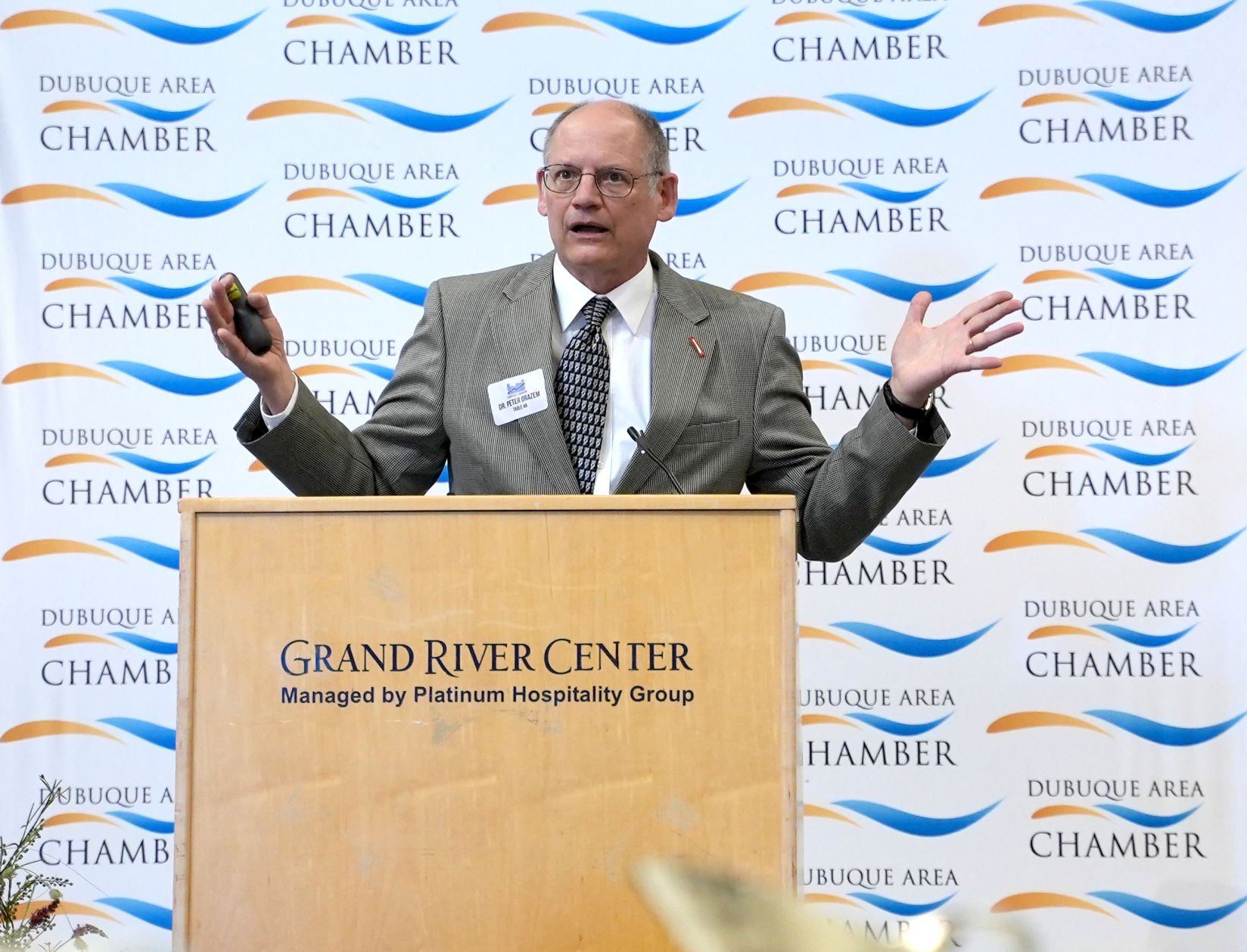A pair of economics experts in Dubuque on Tuesday expressed a hopeful outlook to area business officials regarding the coming year’s economy, though COVID-19-related challenges will continue to play a role.
Peter Orazem, an Iowa State University economics professor, and Elliot Eisenberg, a nationally known economist and public speaker, were the featured speakers at the Dubuque Area Chamber of Commerce’s 2022 Forecast Luncheon. About 200 people attended the event at Grand River Center.
Both speakers showed data and graphs that outlined how the pandemic has affected the past two years, as consumer demand skyrocketed while the labor market took a dive. However, they expressed hope that 2022 will see a trend toward pre-pandemic normalcy.
“We’ll have a tough (first quarter of the year) — there’s no doubt about that,” Eisenberg said. “But we hope by the end of February, omicron has burned out and we move on to bigger and better things.”
Speaking to the Telegraph Herald after the event, chamber President and CEO Molly Grover said the presentations supported the idea that ongoing supply-chain and workforce issues will improve in the months ahead, even as the pandemic persists.
“We’ve learned how to live with the pandemic,” she said. “There is some reason for optimism, which I think is great.”
Building a robust workforce will take some creativity going forward, but Dubuque has shown strong resiliency as the workforce and supply-chain issues were felt locally, Grover said.
She noted that several major local employers intend to grow their workforces. Rite-Hite, Klauer Manufacturing Co. and Hormel Foods Corp. all recently announced expansion plans in Dubuque that would collectively add more than 150 jobs to the area.
“That demonstrates that Dubuque is a competitive place to live, work and play, and that should be celebrated,” she said.
However, Orazem shared some statistics that illustrated the work Iowa still has to do to recover from pandemic-related worker shortages.
He noted the disconnect between unemployment rates and the number of workers available.
As of November, the Dubuque metro area — which includes all of Dubuque County — had an unemployment rate of 2.7%. That represented a decrease from 4% one year earlier and a return to pre-pandemic levels.
However, the county’s overall labor force was markedly smaller than it was two years ago. In November, Dubuque County’s civilian labor force totaled 54,500, compared to 56,800 in November 2019.
Meanwhile, wages also rose during the pandemic, with Dubuque showing an average hourly wage increase from $27.52 to $28.07 from November 2020 to November 2021, he said.
“Across almost all parts of Iowa, except Cedar Rapids, wages rose,” Orazem added.
However, Orazem said Iowa’s biggest challenge in building back up the labor force is its older population. The number of people ages 25 to 54 — what Orazem called the most in-demand age group for employers — in the state dropped by 1% in the state’s available labor force over the course of the pandemic. The percentage drop was even greater for the age groups older than that.
“The age structure is causing a huge problem,” he said. “The response is moving much more slowly to labor force recovery in Iowa. … And every other state wants the same workers.”
Eisenberg said the national workforce has lost 3 million people since the pandemic began for a variety of reasons, including people who chose to retire, a lack of day care resources for working parents and the hundreds of thousands of people in the workforce who died from COVID-19 or became too sick to work.
“People left (the workforce) who could afford to leave, or they were too afraid to go back to their jobs,” he said.
Eisenberg added that the decreased workforce couldn’t keep up with the skyrocketing spending that occurred.
After taking a dive at the start of the pandemic, people began spending more money as they received stimulus payments and other COVID-19-related government benefits. From February 2020 to the start of 2021, Eisenberg noted that spending on consumer goods increased by 20% and has remained that high.
“The insatiable demand recovered instantly, but the supply chain hasn’t recovered (from the spending increase),” he said.
However, he said data indicate complications with the supply chain and shipping delays appear to have peaked, meaning a trend toward normal rates might be coming.
“I believe we’ve seen the worst of the supply-chain problem,” he said. “The question is if we see this going back down over a month, six months or 12 months. It may take until 2023. It may take a long time.”


